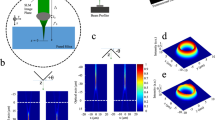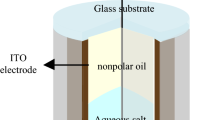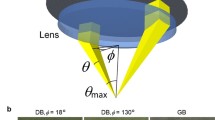Abstract
In this paper, we demonstrate a simple and rapid high focal number (F#) micro-lens (ML) fabrication method using a simple microfluid pulse jetting technology. The simulation of the microfluid pulse jetting is firstly studied to prove that the new jetting method have the potential for jetting the UV polymer with a low surface tension coefficient stably. As the high F# of the ML is ascribed to the low contact angle of the ML on the substrate, a simple surface treatment of the substrate is adopted to obtain a small contact angle of the UV polymer on the substrate. Based on this method, the spherical ML and cylindrical ML with a F# as high as 11.5 have been successfully fabricated. The fabricated high F# ML is characterized through simulating the modulation transfer function curve, wavefront aberration, and point spread function (PSF) and measuring the PSF and imaging effect, and the simulation and measurement results indicate that the diffraction limit optical performance of the high F# ML can be achieved and the clear images can be observed.















Similar content being viewed by others
References
Ahmed R, Yetisen AK, Butt H (2017) High numerical aperture hexagonal stacked ring-based bidirectional flexible polymer microlens array. ACS Nano 11(3):3155–3165
Ares M, Royo S, Caum J (2007) Shack-Hartmann sensor based on a cylindrical microlens array. Opt Lett 32(7):769–771
Bi X, Li W (2015) Fabrication of flexible microlens arrays through vapor-induced dewetting on selectively plasma-treated surfaces. J Mater Chem C 3(22):5825–5834
Bian R, Xiong Y, Chen X et al (2015) Ultralong focal length microlens array fabricated based on SU-8 photoresist. Appl Opt 54(16):5088–5093
Chang CY, Tsai MH (2015) Development of a continuous roll-to-roll processing system for mass production of plastic optical film. J Micromech Microeng 25(12):125014
Chang CY, Yu CH (2015) A basic experimental study of ultrasonic assisted hot embossing process for rapid fabrication of microlens arrays. J Micromech Microeng 25(2):025010
Chen L, Kirchberg S, Jiang BY et al (2014) Fabrication of long-focal-length plano-convex microlens array by combining the micro-milling and injection molding processes. Appl Opt 53(31):7369–7380
Choi HK, Ahsan MS, Yoo D et al (2015) Formation of cylindrical micro-lens array on fused silica glass surface using CO2 laser assisted reshaping technique. Opt Laser Technol 75:63–70
Cox WR, Hayes DJ, Chen T et al (1995) Fabrication of micro-optics by microjet printing. Micro-Opt Micromech Laser Scanning Shap Int Soc Opt Photon 2383:110–116
Cox WR, Chen T, Guan C et al (1998) Micro-jet printing of refractive microlenses. In: Proc. OSA Diffract. Opt. Micro-opt. Topical Mtg
Deng Z, Chen F, Yang Q et al (2012) A facile method to fabricate close-packed concave microlens array on cylindrical glass. J Micromech Microeng 22(11):115026
Deng Z, Yang Q, Chen F et al (2015) Fabrication of large-area concave microlens array on silicon by femtosecond laser micromachining. Opt Lett 40(9):1928–1931
Dong BZ, Liu J, Gu BY et al (2001) Rigorous electromagnetic analysis of a microcylindrical axilens with long focal depth and high transverse resolution. JOSA A 18(7):1465–1470
Fakhfouri V, Cantale N, Mermoud G et al (2008) Inkjet printing of SU-8 for polymer-based MEMS a case study for microlenses. In: IEEE 21st International conference on micro electro mechanical systems, MEMS 2008. IEEE, pp 407–410
Gex F, Horville D, Lelievre G et al (1996) Improvement of a manufacturing technique for long focal length microlens arrays. Pure Appl Opt 5(6):863
Hsieh HT, Su GDJ (2010) A novel boundary-confined method for high numerical aperture microlens array fabrication. J Micromech Microeng 20(3):035023
Hsieh HT, Lin V, Hsieh JL et al (2011) Design and fabrication of long focal length microlens arrays. Opt Commun 284(21):5225–5230
Jacot-Descombes L, Gullo MR, Cadarso VJ et al (2012) Fabrication of epoxy spherical microstructures by controlled drop-on-demand inkjet printing. J Micromech Microeng 22(7):074012
Jeong KH, Lee LP (2002) A new method of increasing numerical aperture of microlens for biophotonic MEMS. In: Second annual international IEEE-EMB special topic conference on microtechnologies in medicine and biology. IEEE, pp 380–383
Jucius D, Grigaliūnas V, Lazauskas A et al (2017) Effect of fused silica surface wettability on thermal reflow of polymer microlens arrays. Microsyst Technol 23(6):2193–2206
Kim JY, Brauer NB, Fakhfouri V et al (2011) Hybrid polymer microlens arrays with high numerical apertures fabricated using simple ink-jet printing technique. Opt Mater Express 1(2):259–269
Kim JY, Pfeiffer K, Voigt A et al (2012) Directly fabricated multi-scale microlens arrays on a hydrophobic flat surface by a simple ink-jet printing technique. J Mater Chem 22(7):3053–3058
Kong LB, Cheung CF (2012) Modeling and characterization of surface generation in fast tool servo machining of microlens arrays. Comput Ind Eng 63(4):957–970
Kuo JN, Hsieh CC, Yang SY et al (2007) An SU-8 microlens array fabricated by soft replica molding for cell counting applications. J Micromech Microeng 17(4):693
Li ZA (2014) Digital droplet micro-jetting prepared microfluidic chip technology and its experimental research. Nanjing University of Science and Technology
Li X, Ding Y, Shao J et al (2012) Fabrication of microlens arrays with well-controlled curvature by liquid trapping and electrohydrodynamic deformation in microholes. Adv Mater 24(23):165
Li P, Pei J, Pan L et al (2014) Fabrication method of low f-number microlens arrays by using surface coating and epoxy dispensing technology. J Micro/Nanolithogr MEMS MOEMS 13(2):023004
Lin V, Wei HC, Hsieh HT et al (2011) An optical wavefront sensor based on a double layer microlens array. Sensors 11(11):10293–10307
Lu DX, Zhang YL, Han DD et al (2015) Solvent-tunable PDMS microlens fabricated by femtosecond laser direct writing. J Mater Chem C 3(8):1751–1756
Luo Z, Duan J, Guo C (2017) Femtosecond laser one-step direct-writing cylindrical microlens array on fused silica. Opt Lett 42(12):2358–2361
Ottevaere H, Cox R, Herzig HP et al (2006) Comparing glass and plastic refractive microlenses fabricated with different technologies. J Opt A: Pure Appl Opt 8(7):S407
Pericet-Camara R, Best A, Nett SK et al (2007) Arrays of microlenses with variable focal lengths fabricated by restructuring polymer surfaces with an ink-jet device. Opt Express 15(15):9877–9882
Poon PCH, Commander LG, Selviah DR et al (1999) Extension of the useful focal length range of microlenses by oil immersion. J Opt A 1(2):133
Popovic ZD, Sprague RA, Connell GAN (1988) Technique for monolithic fabrication of microlens arrays. Appl Opt 27(7):1281–1284
Sutanto E, Tan Y, Onses MS et al (2014) Electrohydrodynamic jet printing of micro-optical devices. Manuf Lett 2(1):4–7
Vespini V, Coppola S, Todino M et al (2016) Forward electrohydrodynamic inkjet printing of optical microlenses on microfluidic devices. Lab Chip 16(2):326–333
Voigt A, Ostrzinski U, Pfeiffer K et al (2011) New inks for the direct drop-on-demand fabrication of polymer lenses. Microelectron Eng 88(8):2174–2179
Wang M, Yu W, Wang T et al (2015) A novel thermal reflow method for the fabrication of microlenses with an ultrahigh focal number. RSC Adv 5(44):35311–35316
Warrant EJ, McIntyre PD (1991) Strategies for retinal design in arthropod eyes of low F-number. J Comp Physiol A 168(4):499–512
Xie D, Zhang H, Shu X et al (2012) Fabrication of polymer micro-lens array with pneumatically diaphragm-driven drop-on-demand inkjet technology. Opt Express 20(14):15186–15195
Xie D, Chang X, Shu X et al (2015) Rapid fabrication of thermoplastic polymer refractive microlens array using contactless hot embossing technology. Opt Express 23(4):5154–5166
Xie D, Chang X, Shu X et al (2016) Replication of thermoplastic polymer spherical lens array using microforged molding technique. Opt Express 24(26):30264–30274
Xing J, Rong W, Sun D et al (2016) Extrusion printing for fabrication of spherical and cylindrical microlens arrays. Appl Opt 55(25):6947–6952
Ye JS, Mei GA, Zheng XH et al (2012) Long-focal-depth cylindrical microlens with flat axial intensity distributions. J Modern Opt 59(1):90–94
Yoon GY, Jitsuno T, Nakatsuka M et al (1996) Shack Hartmann wave-front measurement with a large F-number plastic microlens array. Appl Opt 35(1):188–192
Zhu X, Zhu L, Chen H et al (2015a) Fabrication of multi-scale micro-lens arrays on hydrophobic surfaces using a drop-on-demand droplet generator. Opt Laser Technol 66:156–165
Zhu X, Zhu L, Chen H et al (2015b) Fabrication of high numerical aperture micro-lens array based on drop-on-demand generating of water-based molds. Opt Laser Technol 68:23–27
Acknowledgements
This project is supported by National Natural Science Foundation of China (Grant No. 51705271), Shandong Provincial Natural Science Foundation, China (No. ZR2017QEE018), and A Project of Shandong Province Higher Educational Science and Technology Program (J17KA032).
Author information
Authors and Affiliations
Corresponding author
Electronic supplementary material
Below is the link to the electronic supplementary material.
Supplementary material 1 (MP4 9703 kb)
Supplementary material 2 (MP4 4028 kb)
Supplementary material 3 (MP4 4187 kb)
Rights and permissions
About this article
Cite this article
Zhu, X., Lan, H., Yang, J. et al. Simple fabrication of high focal number micro-lenses based on a microfluid pulse jetting method. Microsyst Technol 24, 2789–2802 (2018). https://doi.org/10.1007/s00542-018-3721-9
Received:
Accepted:
Published:
Issue Date:
DOI: https://doi.org/10.1007/s00542-018-3721-9




